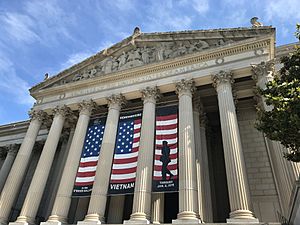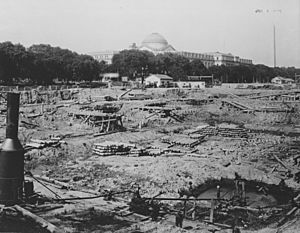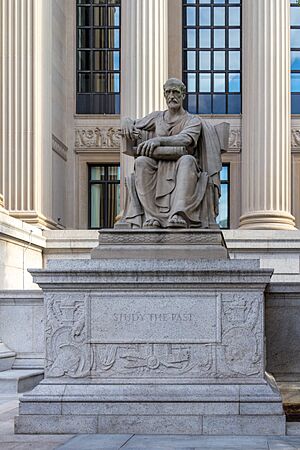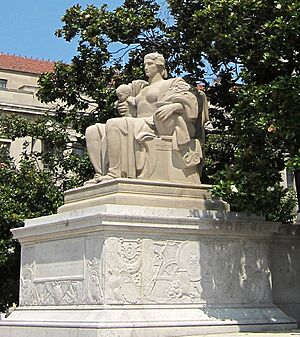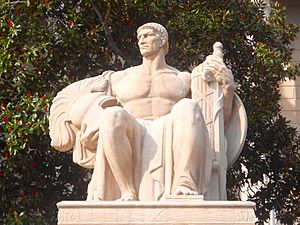National Archives Building facts for kids
|
National Archives Building
|
|
|
U.S. Historic district
Contributing property |
|
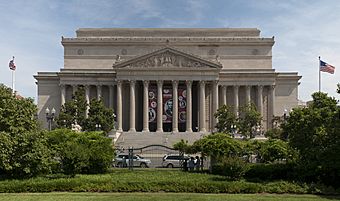
The National Archives Building in Washington, D.C.
|
|
| Location | Constitution Avenue between 7th Street and 9th Street, NW, Washington, D.C., U.S. |
|---|---|
| Built | 1935 |
| Architect | John Russell Pope |
| Architectural style | Classical Revival |
| Part of | Pennsylvania Avenue National Historic Site (ID66000865) |
| NRHP reference No. | 71001004 (NRHP listing) 100009816 (NHL designation) |
Quick facts for kids Significant dates |
|
| Added to NRHP | May 27, 1971 |
| Designated NHL | December 11, 2023 |
| Designated CP | October 15, 1966 |
The National Archives Building, also called Archives I, is the main building for the United States National Archives and Records Administration. It is located in Washington, D.C., near the National Mall. The main entrance is on Constitution Avenue, and the research entrance is on Pennsylvania Avenue. There is also a larger building, Archives II, in College Park, Maryland.
This building was constructed in the 1930s. In December 2023, it was named a National Historic Landmark. It was added to the National Register of Historic Places in 1971. It is also part of the Pennsylvania Avenue National Historic Site.
Contents
Explore Important Documents
The National Archives Building keeps original copies of three very important documents for the United States. These are the Declaration of Independence, the Constitution, and the Bill of Rights. You can see these documents on display in a special room called the Rotunda. This area is known as the Charters of Freedom. The Emancipation Proclamation was added to this display in 2026.
The building also holds other key American historical items. These include the Continental Association, the Articles of Confederation, and the Louisiana Purchase Treaty. You can also find collections of old photos and other important items from American and world history. One special item is an original version of the 1297 Magna Carta, which was confirmed by Edward I.
Between 2003 and 2004, the National Archives also had special displays. These included the Gettysburg Address and the Emancipation Proclamation. In the Rotunda, visitors can walk freely from one document to another. You can take photos in research rooms using natural light.
Building History
Why the Archives Building Was Needed
For almost 150 years, the U.S. government did not have a safe place to keep its important records. Many valuable documents were lost or destroyed, often by fires. By the late 1800s, people realized a special building was needed. Architects even started drawing plans for an archives building. By the early 1900s, a strong effort began to create the National Archives. Finally, in 1926, Congress approved the building's construction.
Designing the Building
In 1926, Congress approved the National Archives Building. This was part of a big plan to make downtown Washington, D.C., more beautiful. It also aimed to provide office space for the growing government. This plan led to the creation of buildings in the Federal Triangle area. Andrew W. Mellon, who was the Secretary of the Treasury, put together a group of architects to design these buildings.
An architect named Louis A. Simon made an early design for the Archives. He planned to put it on Pennsylvania Avenue. However, in 1929, a group called the Commission of Fine Arts did not like Simon's design. They suggested that a famous architect, John Russell Pope, should design the National Archives. Pope joined the team after another member passed away.
John Russell Pope changed both the location and the design of the building. He thought the Archives should be on the block between Seventh and Eighth Streets. He believed this spot needed a grand building. Pope designed the National Archives to look like a classical temple. This style was perfect for a place dedicated to American history. The land for the building was already home to the Center Market, which was taken down to make way for the new Archives.
Starting Construction
Construction on the National Archives began on September 5, 1931. President Herbert Hoover laid the cornerstone in February 1933. Building the Archives was challenging. The huge structure was built over an underground stream called the Tiber Creek. Workers had to drive 8,575 piles into the soft ground. Then, they poured a large concrete base to create a strong foundation.
Another challenge was choosing building materials. Both limestone and granite were allowed. However, construction happened during the Great Depression. Companies that supplied these stones strongly pushed for their material to be used. In the end, limestone was used for the outside walls. Granite was used for the base, just like other buildings in the Federal Triangle. The limestone came from Indiana.
Building the Archives
Building the National Archives was a huge job. It was the most detailed building in the Federal Triangle. It needed special air systems and filters to protect the records. The floors also had to be extra strong. Thousands of feet of shelving were installed to store all the documents. The outside of the building took over four years to finish. Many different workers, like sculptors and steel workers, helped build it.
Finishing the Project
In November 1935, 120 staff members moved into the building. The outside was mostly done, but many storage areas still needed shelves. Work also continued on the Rotunda and other public spaces. Soon, it became clear that the building would not have enough storage space. A project began to fill the building's inner courtyard. This doubled the storage space from about 374,000 square feet to over 757,000 square feet.
The idea of the Archives as a "temple of history" has been kept alive. The building has been maintained and restored since the 1930s. However, more and more records filled the building over the years. Even with the courtyard expansion, space became limited. By the late 1960s, the building was full. The agency had to start renting extra storage and office space. In 1993, a second National Archives building opened in College Park, Maryland. This new building added 1.8 million square feet of space. It became one of the most modern archives in the world.
Protecting the Documents
The Declaration of Independence, the Constitution, and the Bill of Rights have been on display since 1952. That year, experts placed the documents in special sealed cases. These cases were filled with a gas called helium. Experts believed this would protect the documents for a very long time. Since 1952, conservators (people who preserve old things) have regularly checked the documents. Since 1987, they have used an electronic imaging system developed by NASA to help with these checks.
In 1995, conservators noticed changes in the glass cases of the Declaration of Independence and the Bill of Rights. Glass experts found that the glass was starting to wear out. They recommended that the documents be put into new cases within seven years. This was to make sure the documents stayed safe.
In July 2001, the Charters were removed from display. Conservators took them out of their old cases and checked their condition. They did any necessary preservation work on each document. The documents were then placed in new cases. They returned to public display in September 2003.
Key Dates for the Building
- Congress approved construction in 1926.
- Groundbreaking happened on September 5, 1931.
- President Herbert Hoover laid the cornerstone in February 1933.
- The building first opened in 1935.
- It was fully completed in 1937.
- A major renovation finished in late 2004.
- The public display area grew from 12,000 to over 19,000 square feet in 2013.
Statues at the Archives
Outside the National Archives Building, there are four large statues. They were carved between 1934 and 1935. The artists were likely chosen by the building's designer, John Russell Pope. These statues are made from huge pieces of limestone. They were shipped from Indiana to Washington, D.C., on special flat trains.
Two statues are on the south side of the building, and two are on the north side. Each statue weighs 65 tons and is 10 feet tall. With their bases, they stand 25 feet high.
On the north side, one statue shows an old man, called Past. The other shows a young woman, called Future or Present. These were made by Robert Aiken. The man's base says, "Study the Past," a quote from Confucius. The woman's base says, "What is Past is Prologue," from a play called The Tempest.
On the south side, the statues are named Heritage and Guardianship. These were carved by James Earl Fraser. Heritage shows a woman with a child, wheat, and an urn. These items represent the government's role in protecting homes. Her base says, "The heritage of the past is the seed that brings forth the harvest of the future." Guardianship shows a strong man holding a sword and a helmet. His base says, "Eternal Vigilance is the Price of Liberty," a quote from Thomas Jefferson.
There are also other sculptures on the building's triangular sections above the entrances. These figures represent ideas like history, inspiration, destiny, and protection.
Images for kids
See also
- Architecture of Washington, D.C.



